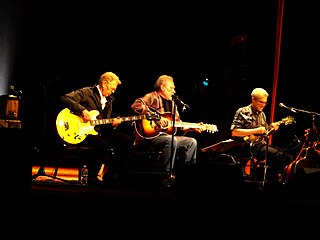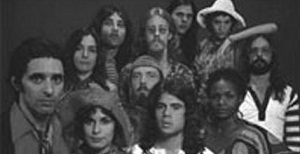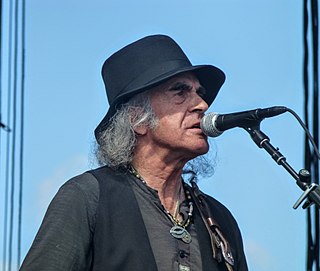
Jefferson Airplane was an American rock band formed in San Francisco, California in 1965. One of the pioneering bands of psychedelic rock, the group defined the San Francisco Sound and was the first from the Bay Area to achieve international commercial success. They headlined the Monterey Pop Festival (1967), Woodstock (1969), Altamont Free Concert (1969), and the first Isle of Wight Festival (1968) in England. Their 1967 breakout album Surrealistic Pillow was one of the most significant recordings of the Summer of Love. Two songs from that album, "Somebody to Love" and "White Rabbit", are among Rolling Stone's "500 Greatest Songs of All Time".

Blue Cheer was an American rock band that initially performed and recorded in the late 1960s and early 1970s and was sporadically active until 2009. Based in San Francisco, Blue Cheer played in a psychedelic blues rock or acid rock style. They are also credited as being some of the earliest pioneers of heavy metal, with their cover of "Summertime Blues" sometimes cited as the first in the genre. They have also been noted as influential in the development of genres as disparate as punk rock, stoner rock, doom metal, experimental rock, and grunge.

Quicksilver Messenger Service is an American psychedelic rock band formed in 1965 in San Francisco. The band achieved wide popularity in the San Francisco Bay Area and, through their recordings, with psychedelic rock enthusiasts around the globe, and several of their albums ranked in the Top 30 of the Billboard Pop charts. They were part of the new wave of album-oriented bands, achieving renown and popularity despite a lack of success with their singles. Though not as commercially successful as contemporaries Jefferson Airplane and the Grateful Dead, Quicksilver was integral to the beginnings of their genre. With their jazz and classical influences and a strong folk background, the band attempted to create an individual, innovative sound. Music historian Colin Larkin wrote: "Of all the bands that came out of the San Francisco area during the late '60s, Quicksilver typified most of the style, attitude and sound of that era."

Hot Tuna is an American blues rock band formed in 1969 by former Jefferson Airplane members Jorma Kaukonen (guitarist/vocals) and Jack Casady (bassist). Although it has always been a fluid aggregation, with musicians coming and going over the years, the band's center has always been Kaukonen and Casady's ongoing collaboration.

Vincebus Eruptum is the debut album of American rock band Blue Cheer. Released on January 16, 1968, the album features a heavy-thunderous blues sound, which would later be known as heavy metal.

Live/Dead is the first official live album released by the rock band Grateful Dead. Recorded over a series of concerts in early 1969 and released later the same year, it was the first live rock album to use 16-track recording.

John Cipollina was a guitarist best known for his role as a founder and the lead guitarist of the prominent San Francisco rock band Quicksilver Messenger Service. After leaving Quicksilver he formed the band Copperhead, was a member of the San Francisco All Stars and later played with numerous other bands.

Fillmore West 1969: The Complete Recordings is a 10-CD live album by the rock band the Grateful Dead. It contains four complete concerts recorded on February 27, February 28, March 1, and March 2, 1969, at the Fillmore West in San Francisco. The album was remixed from the original 16-track concert soundboard tapes. It was released as a box set in November 2005, in a limited edition of 10,000 copies.
Michael Waller was an English drummer, who played with many of the biggest names on the UK rock and blues scene, after he became a professional musician in 1960. In addition to being a member, albeit sometimes briefly, of some of the seminal bands of the 1960s, Waller played as a session musician with a host of UK and US artists.

Outsideinside is the second album by American rock trio Blue Cheer. Philips Records released the album in August 1968, only seven months after their debut LP, Vincebus Eruptum.

New! Improved! is the third album by American rock group Blue Cheer. Released in March 1969 by Philips Records, it is their first without original guitarist Leigh Stephens. The album features songs recorded by two different group lineups: in addition to bassist and vocalist Dickie Peterson and drummer Paul Whaley, side one includes Bruce Stephens on guitar and Burns Kellogg on keyboards; while side two includes Randy Holden on guitar and vocals.
Eric Albronda is an American musician. Albronda was the first drummer for Blue Cheer, briefly, prior to being replaced by Paul Whaley. He also co-produced Red Weather, the first solo album by former Blue Cheer guitarist Leigh Stephens, as well as the eponymous solo album by one of Stephens' post Blue Cheer bands, Pilot.

Paul Gene Whaley was an American drummer best known as the drummer for rock band Blue Cheer. He was the son of country music singer Paul Edward Whaley. He grew up in the towns of Vallejo and Winters, California. He played drums with a Davis, California band called the Oxford Circle. Whaley is credited on the Oxford Circle album Live at the Avalon 1966. When he left the Oxford Circle to join Blue Cheer in 1967, the former band dissolved. He was the longest-standing member in Blue Cheer following Peterson's death at age 63. Whaley died of heart failure on January 28, 2019, two weeks after his 72nd birthday.

Stoneground was an American rock band formed in 1970 in Concord, California. Originally a trio, Stoneground expanded to a 10-piece band by the time of their eponymous 1971 debut album. The group appeared in two films, Medicine Ball Caravan (1971) and Dracula A.D. 1972 (1972), and released three albums before singer Sal Valentino quit in 1973. Three other band members—Cory Lerios, Steve Price and David Jenkins—left to form pop group Pablo Cruise. Stoneground continued as an act through 1982, with only Tim Barnes and Annie Sampson remaining from the early incarnation of the band. Barnes and Price led a re-formed Stoneground in 2003 and released a studio album the following year.

"The Hunter" is a blues song first recorded by Albert King in 1967 for his landmark album Born Under a Bad Sign. It was written by Stax Records' house band, Booker T. and the MGs, and Carl Wells. Along with "Born Under a Bad Sign" and "Crosscut Saw", "The Hunter" is one of King's best-known and most-recorded songs. In 1969, Ike & Tina Turner's version reached the singles charts in the U.S.

Peter Roy Sears is an English rock musician. In a career spanning more than six decades, he has been a member of many bands and has moved through a variety of musical genres, from early R&B, psychedelic improvisational rock of the 1960s, folk, country music, arena rock in the 1970s, and blues. He usually plays bass, keyboards, or both in bands.
Trader Horne was a British duo, consisting of multi-instrumentalist and former Them keyboard player and vocalist Jackie McAuley, and former Fairport Convention lead vocalist Judy Dyble. The short-lived musical partnership broke up after releasing only one LP, Morning Way, in 1970. The band was named after DJ John Peel's nanny, Florence Horne, nicknamed "Trader" in reference to explorer Trader Horn.

Dave's Picks Volume 6 is a three-CD live album by the rock band the Grateful Dead. It contains two complete concerts: one from December 20, 1969, at the Fillmore Auditorium in San Francisco and the second from February 2, 1970, at the Fox Theatre in St. Louis. It was produced as a limited edition of 13,000 numbered copies, and was released on May 1, 2013.
Abe Keshishian, known professionally as Abe "Voco" Kesh was an American disc jockey and record producer. He is best-known for discovering the seminal hard rock band Blue Cheer, and for producing their first two albums, Vincebus Eruptum and Outsideinside. He also produced the band's 1968 Top 10 cover of Eddie Cochran's "Summertime Blues."
Pacific Recorders was an independent recording studio in San Mateo, California. Founded in 1968, the studio was the location for recordings by such notable artists as Santana, the Grateful Dead, The Doobie Brothers, Moby Grape, and Taj Majal.














